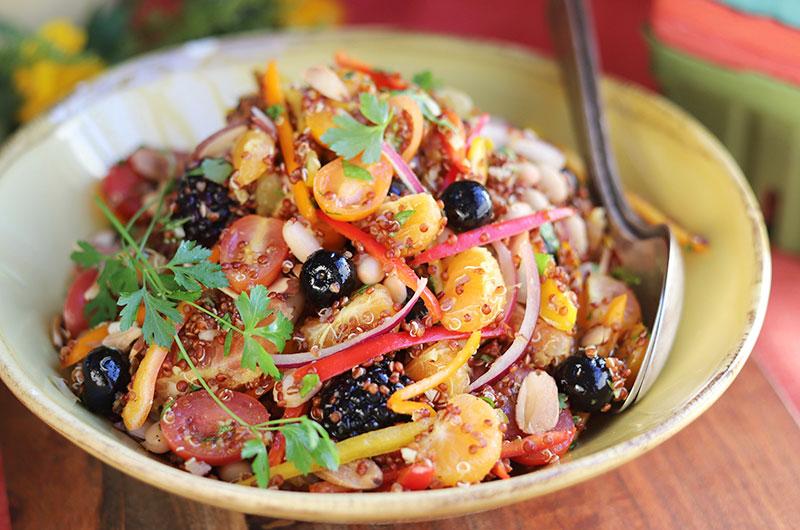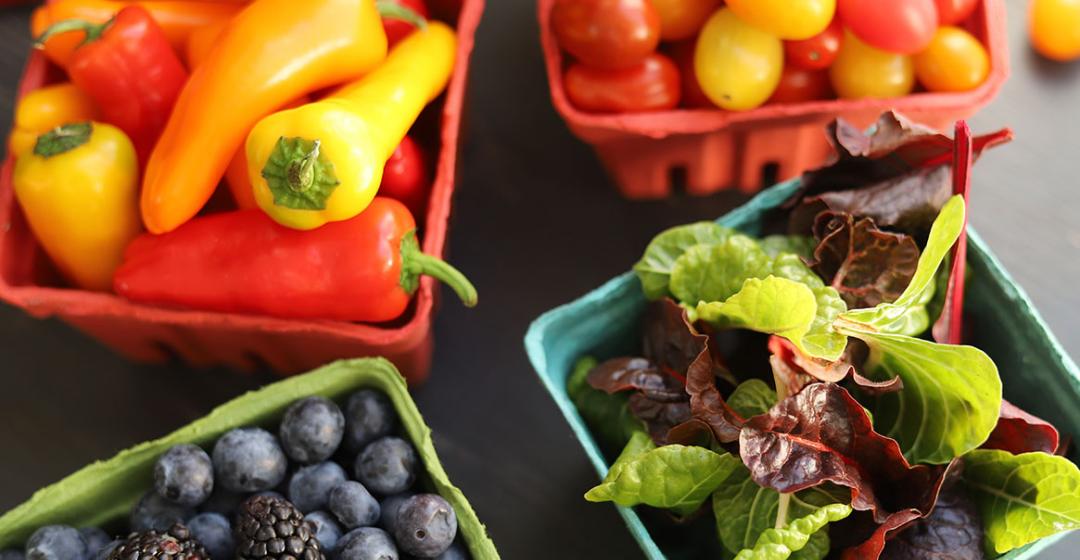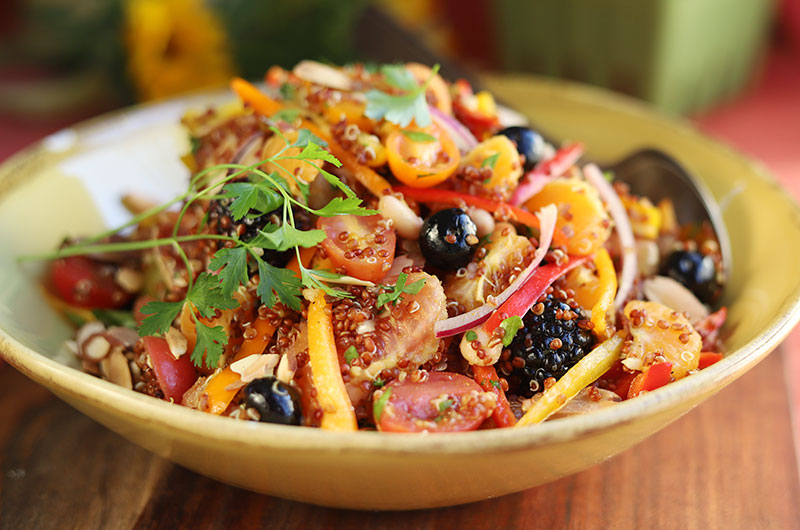At a recent editorial meeting, I mentioned I was going to write about immunity gardens for the magazine. “Oh, community gardens,” someone said. “Nice.” “No, she said immunity gardens, didn’t she?” someone else said. “Community immunity gardens?” said another. (This was on Zoom; blame the computer audio.) “Well,” I laughed, “I’d love to write about community immunity gardens, but we’d all have to wear our masks.”
But, in fact, you don’t have to wear a mask – or even plant a garden if you don’t want to – to eat more fresh fruits and vegetables that lower inflammation and help boost your immune system. All you have to do is eat your colors. Bright, bold, saturated colors: crimson tomatoes, peppers the color of a Vineyard sunset, blueberries blacker than midnight, spinach straight outta the Emerald City.
I realize you’re probably aware of this whole color-scheme thing and that you, like me, are trying your best to eat well. But when the pandemic came along, grocery store sales of vegetables went up 40 percent; then home vegetable gardens multiplied like field bunnies. So it didn’t surprise me when the next shift occurred. Suddenly a general interest in healthy eating morphed into an intense focus on so-called “superfoods” – colorful, nutrient-rich foods with multiple health benefits. “Superfoods” might be a bit of a marketing hype, but that doesn’t mean there aren’t great reasons to eat more (and grow more) of these vegetables and fruits.

Hence, for 2021, the “immunity garden.” At least, that’s what Burpee’s GardenCast is calling it. (Other trends, not surprisingly, include planting “gardens of joy,” “quiet gardens,” and “world herb gardens.”) Clearly, we’re asking a lot of our gardens. But they can deliver, right into our kitchens.
I’m not ashamed to admit that over the winter I gave my seed choices a second look and came up with a few more colorful and nutrient-packed choices to grow – and cook with – this year.
According to UC Davis Health, two of the most important nutrients for staying healthy in Covid times are vitamin A (specifically its precursor, beta-carotene) and vitamin C. Vitamin A fosters a strong respiratory system and helps keep your intestines healthy. Carrots, sweet potatoes, dark leafy greens (spinach, kale, and mustard greens especially), and fall squashes, such as butternut, have the most beta-carotene per serving. But broccoli, red bell peppers, romaine lettuce, and podded peas (sugar snaps, snow peas) are good sources too. Strawberries and red bell peppers are excellent sources of vitamin C, the powerful antioxidant known to help boost our immune systems. Chili peppers, Brussels sprouts, and parsley also supply vitamin C.
In addition to vitamins A and C, many fruits and vegetables are naturally anti-inflammatory, which is an extremely beneficial quality since chronic inflammation has been linked to major diseases, including cancer, diabetes, and heart disease. At the top of the anti-inflammatory list: leafy greens (especially spinach and kale), broccoli, cabbage, beans, and berries. And garlic, of course!
Berries have yet another thing going for them: anthocyanins, the flavonoid which contributes the reddish-purple coloring to blackberries, blueberries, raspberries, black currants, red currants, Concord grapes, red cabbage, and other purple vegetables. Anthocyanins, according to the National Institutes of Health, have anti-inflammatory, antioxidant, and anti-microbial properties. Their benefits can be diminished by heat, so eating these foods raw is smart.
And then there are tomatoes. Fortunately, this favorite garden vegetable is also a nutritional powerhouse. In addition to its famous supply of heart-healthy, anti-inflammatory lycopene, one tomato is a bundle of vitamin C, vitamin A, folic acid, lutein, potassium, phosphorus, and calcium (as well as fiber, protein, and carbohydrates.) Fun fact: cherry tomatoes contain more beta-carotene than larger tomatoes.
So how can you grow the most colorful, nutrient-rich vegetables in your garden this year? If you don’t have a ton of space and don’t want to wait all summer for vegetables that take 100 days to mature, my first piece of advice is to think in miniature.
Mini or smaller vegetables often yield earlier and produce more. Fairy Tale eggplants are a good example. This year, instead of full-size peppers, I’m planting Lunchbox mini-bell pepper varieties that produce lots of red, yellow, and orange three-inch peppers that mature weeks earlier than bigger peppers. Instead of full-size butternut squash, I’m planting little Honeynuts. Instead of beefsteaks, I’m growing more cherry and grape tomatoes (including an especially prolific variety called Valentine) that ripen earlier and yield generously. No garden? Grow dwarf cherry tomatoes and chili peppers in pots on your deck.
Some highly nutritious vegetables, such as carrots, take longer to mature. But if you plant two or three varieties, you’ll have a succession of harvests well into fall. Start with a small carrot called Adelaide that matures in fifty days, and add Yaya, a tasty variety that matures in fifty-eight days and holds well in the summer. Be sure to include deeply colored carrots for the most beta-carotene. I like Scarlet Nantes, but Purple Haze gets all the rave these days. A purple carrot with an orange core, it has both anthocyanins and beta-carotene.
What about those leafy greens? Sure, you can plant spinach, but it’s slow to germinate and yields less than other quicker-growing greens, such as Red Russian kale and Ruby Streaks mustard that can be harvested as beautiful baby greens for salads. Bright Lights Swiss chard is a gorgeous and nutritious spinach substitute, and one planting can go straight through summer and fall if you harvest leaves from the outside of the plant. I also like quick-growing Japanese turnips, a tasty radishlike root with vitamin C–rich greens.
And don’t wait to get those berries started. Splurge on a couple of mature blueberry plants and maybe a thornless blackberry or two and you’ll have berries this summer. Order a few bare-root strawberry plants through the mail and find a corner of the (fenced) garden to plunk them in. By next year, they’ll be sprawling all over the place.
In the meantime, we’re lucky to have so many farm stands here on the Vineyard that provide us with fresh Island-grown nutrition. So while you’re waiting for your garden to grow, you can still eat – and cook – your colors. To help the cause, I’m offering a versatile salad recipe packed with lycopene, beta-carotene, anthocyanins, protein, and fiber. Plus, it tastes good, so there’s that.








